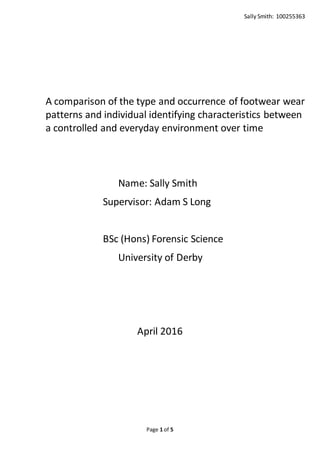
IS for LinkedIn
- 1. Sally Smith: 100255363 Page 1 of 5 A comparison of the type and occurrence of footwear wear patterns and individual identifying characteristics between a controlled and everyday environment over time Name: Sally Smith Supervisor: Adam S Long BSc (Hons) Forensic Science University of Derby April 2016
- 2. Sally Smith: 100255363 Page 2 of 5 Acknowledgements I would like to thank my supervisor Adam Long for his guidance throughout this project and Dr Ian Turner for his help in preventing a statistic related crisis. I wish to thank Ceri Heldreich for her assistance in booking the sports and exercise treadmill equipment and allowing me to make the sports laboratory my home for six months! I would additionally like to thank my family and friends for kindly proofreading this thesis and their enduring support while I completed approximately: 111 hours of walking; Covering 179.81 kilometres; Taking 392,188 steps; Burning 6815.76 kilocalories and Analysed 198 images.
- 3. Sally Smith: 100255363 Page 3 of 5 Abstract Footwear evidence is often disregarded in favour of DNA or fingerprints. The purpose of this study was to determine the influence of surfaces on footwear wear by investigating whether the number and type of wear characteristics differed between laboratory controlled simulated walking and an external natural setting over time. Canvas trainer shoes were chosen as the type of footwear due to worldwide popularity. Data was collected for 0 to 720min (12 hours) of wear and surface was found to be a determining factor. Further investigations have been suggested to confirm these results. Seven types of feature: cuts/scratches, chunk outs, foreign material, holes, stone holds, tears and other were selected for analysis after consultation with pertinent literature. Statistical analysis confirmed more features were found in the control environment (p ≤ 0.05) attributed to the less abrasive surface and lower overall percentage wear. Features in the everyday environment were thought to be obliterated quicker due to the extensive wear of the outsole. It was discovered that certain types of features were shown to be more prevalent in one environment and a strong positive correlation was found between features and time. Findings support that footwear evidence has uniqueness developed by many influencing factors and should be held in higher regard in court.
- 4. Sally Smith: 100255363 Page 4 of 5 Conclusion The findings described within this study show that environment has a significant effect on the number and type of wear features which are acquired by footwear. More features were observed in the control environment which was attributed to the lessened abrasive quality of the treadmill surface and lower overall percentage wear. Features in the everyday environment were suggested to be obliterated at an accelerated rate due to the more extensive wear of the outsole. A prevalence for cuts/scratches and chunk outs were found in the control environment with foreign material, holes and stone holds occurring more frequently in the everyday environment. Furthermore, it has been shown that there is a strong positive correlation between the number of features present and time in both environments and a strong positive correlation between the acquisition rate of the left and right feet. Correlation between the type of feature and time differed depending on environment. Cuts/scratches was the only significant correlation against time in the control environment whereas significant correlations for cuts/scratches, holes, stone holds and tears against time were observed in the everyday environment. The research supports the notion that inked impressions are an out dated practice as suggested by Needham & Sharp (2016). Further investigation is necessary into wear determined by number of steps and surface type due to the present findings. The final purpose of this study was to provide preliminary data for the Bayesian model proposed by Skerett, Neumann & Mateos-Garcia (2011). The findings described here have shown that more factors affect wear than shoe type, an assumption in this model. The findings are also in agreement with redefining the broad categories of wear from toe, heel and combinations thereof with each particular case. The data collated here could therefore provide information for the very early stages of wear from 0 to 12 hours for one gait map (that of the researcher) to begin the wear model.
- 5. Sally Smith: 100255363 Page 5 of 5 At present, the results show how wear patterns appear on the researcher’s footwear alone due to the individuality of wear, supporting the concept that shoemarks are unique to an individual due to gait, the structure of an individual’s foot (Krishna et al., 2015) and the variability in individual identifying characteristics. This element of uniqueness developed by many influencing factors show that footwear evidence is individual in nature and should be held in higher regard in court.